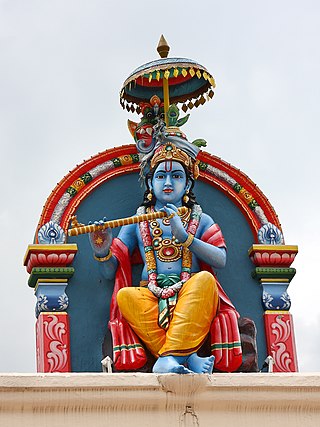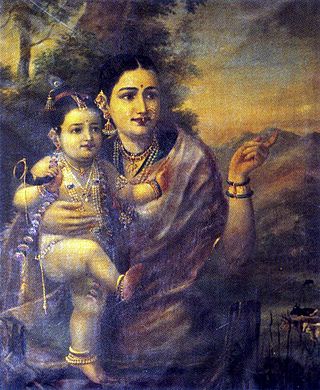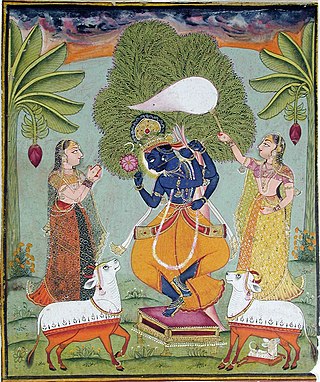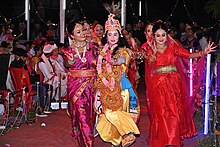
Krishna is a major deity in Hinduism. He is worshipped as the eighth avatar of Vishnu and also as the Supreme God in his own right. He is the god of protection, compassion, tenderness, and love; and is widely revered among Hindu divinities. Krishna's birthday is celebrated every year by Hindus on Krishna Janmashtami according to the lunisolar Hindu calendar, which falls in late August or early September of the Gregorian calendar.

Radha, also called Radhika, is a Hindu goddess and the chief consort of the god Krishna. She is the goddess of love, tenderness, compassion, and devotion. In scriptures, Radha is mentioned as the avatar of Lakshmi and also as the Mūlaprakriti, the Supreme goddess, who is the feminine counterpart and internal potency of Krishna. Radha accompanies Krishna in all his incarnations. Radha's birthday is celebrated every year on the occasion of Radhashtami.

Gopi or Gopika in Hinduism are commonly referred to the group of milkmaids of Braj. They are regarded as the consorts and devotees of Krishna and are venerated for their unconditional love and devotion (Bhakti) to him as described in Bhagavata Purana and other Puranic literature. Gopis are often considered as the expansion of Radha, the chief consort of Krishna. The Raslila of gopis with Krishna has inspired various traditional performance art forms and literatures.

Krishna Janmashtami, also known simply as Krishnashtami, Janmashtami, or Gokulashtami, is an annual Hindu festival that celebrates the birth of Krishna, the eighth avatar of Vishnu. In certain Hindu texts, such as the Gita Govinda, Krishna has been identified as supreme God and the source of all avatars. Krishna's birth is celebrated and observed on the eighth day (Ashtami) of the dark fortnight in Shravana Masa. According to the purnimanta tradition), Krishna's birth is celebrated on the eighth day (Ashtami) of the dark fortnight in Bhadrapada Masa.

Graham M. Schweig is an American scholar of comparative theology of religion, philosophy, and the history of Yoga and Bhakti. He was born in Manhattan, New York and raised in Washington, DC. He joined the faculty at Christopher Newport University in Virginia, in August, 2000, and is currently Professor of Religion and Director of Studies in Religion there. He is also Distinguished Teaching and Research Faculty at The Center for Dharma Studies at the Graduate Theological Union in Berkeley, California, beginning June, 2017.

Manipuri dance, also referred to as the Manipuri Raas Leela, is a jagoi and is one of the major Indian classical dance forms, originating from the state of Manipur. It is one of the greatest cultural achievements of the traditional Vaishnavism adhering Meitei people of Manipur. Owing to the Meitei civilization, the classical dance form, first formally developed by Meitei Hindu king Ching Thang Khomba of the Kingdom of Manipur, is considered to be the highest spiritual expression of the worship of Hindu deity Krishna. Owing to its huge influences on the diverse cultural heritages across the Indian subcontinent, it is recognised by the Sangeet Natak Akademi of the Ministry of Culture of the Government of India as one of the few primary classical dance forms of the Republic of India, and is honoured with the Sangeet Natak Akademi Award for Manipuri annually. It is referred to as the "national dance" during the Armenia-India joint issue of postage stamps, as a part of the Armenia-India international relations.

Rupa Goswami was a devotional teacher (guru), poet, and philosopher of the Gaudiya Vaishnava tradition. With his brother Sanatana Goswami, he is considered the most senior of the Six Goswamis of Vrindavan associated with Caitanya Mahaprabhu, a hidden avatar (incarnation) of Krishna in Kali Yuga.

Jiva Goswami was an Indian philosopher and saint from the Gaudiya Vaishnava school of Vedanta tradition, producing a great number of philosophical works on the theology and practice of Bhakti yoga, Vaishnava Vedanta and associated disciplines. He is known as one of the Six Goswamis of Vrindavan and was the nephew of the two leading figures, Rupa Goswami and Sanatana Goswami.

Radha-Krishna is the combined form of the Hindu god Krishna with his chief consort and shakti Radha. They are regarded as the feminine as well as the masculine realities of God, in several Krishnaite traditions of Vaishnavism.
Uddhava is a character from the Puranic texts of Hinduism, described to be the friend and counsellor of Krishna. He plays a significant role in the Bhagavata Purana, being taught the processes of yoga and bhakti directly by Krishna. The principle of these discussions is often referred to as the Uddhava Gita, similarly to the Bhagavad Gita wherein Krishna instructs Arjuna.

Goloka or Goloka Vrindavan is the celestial abode of the Hindu god Krishna and his chief consort Radha. In the Bhagavata Purana and Garga Samhita, Krishna is portrayed as the highest person who resides in Goloka along with his three wives - Radha, Virija and Bhudevi.

Krishnaism is a term used in scholarly circles to describe large group of independent Hindu traditions—sampradayas related to Vaishnavism—that center on the devotion to Krishna as Svayam Bhagavan, Ishvara, Para Brahman, who is the source of all reality, not simply an avatar of Vishnu. This is its difference from such Vaishnavite groupings as Sri Vaishnavism, Sadh Vaishnavism, Ramaism, Radhaism, Sitaism etc. There is also a personal Krishnaism, that is devotion to Krishna outside of any tradition and community, as in the case of the saint-poet Meera Bai. Leading scholars do not define Krishnaism as a suborder or offshoot of Vaishnavism, considering it at least a parallel and no less ancient current of Hinduism.

Lalita, also commonly called Lalita Sakhi, is the Hindu goddess and one of the most prominent associates of the divine couple Radha Krishna. In many Vaishnaite traditions and literatures, she is revered as the gopi (milkmaid) of the Braj region and is mentioned as the chief of Ashtasakhi, the eight closest eternal companion of Radha and Krishna.

Manipuri Vaishnavism, also known as Meitei Vaishnavism is a regional variant of Gaudiya Vaishnavism with a culture-forming role in the north-eastern Indian state of Manipur.
Rasa refers to the creation and reception of a distinct 'flavor' or quality of something. As a Sanskrit theological concept, rasa was popularized Krishna-centered bhakti traditions, such as Gaudiya Vaishnavism from the fifteenth century. The theological use of the word can be found early, about two thousand years before the Nimbarka or Chaitanya schools of bhakti, in 2.7.1 of the Taittiriya Upanishad: "Truly, the Lord is rasa" This statement expresses the view that God is the one who enjoys the ultimate rasa, or spiritual rapture and emotions.

Gopala Krishna refers to a form of the Hindu deity Krishna, as featured in the Harivamsha and the Puranas. The narratives of Gopala Krishna are set in the cowherd settlement of the Vraja region called Gokulam, where he is raised by his foster-parents, Nanda and Yashoda.

Jai Shri Krishna is an Indian television drama series produced by Sagar Pictures, which aired on Colors TV from 21 July 2008 to 15 September 2009. It is the remake of Ramanand Sagar's successful show Sri Krishna and was handled by his son Moti Sagar of Sagar Pictures. It is based on Mahabharata, Harivamsa, Bhagavata Purana, and the Vishnu Purana.
Sat Sandarbhas is a 16th-century Vaishnava Sanskrit text, authored by Gaudiya Vaishnava theologian Jiva Goswami. The six treatise are Tattva-, Bhagavat-, Paramatma-, Krishna-, Bhakti-, and Priti-sandarbha. Jiva's Krama-sandarbha commentary on the Bhagavata Purana is often described as the "seventh" of the six sandarbhas.

Tamal Krishna Goswami, born Thomas G. Herzig in New York City, New York, United States, served on the International Society for Krishna Consciousness's Governing Body Commission from its inception in 1970. He completed a bachelor's degree in religious studies at Southern Methodist University.

The dance performed during the Raas mela festival is known as Raas Dance. The Raas Purnima festival is the most significant religious and cultural heritage celebration for the Manipuri indigenous community in Bangladesh. This festival is held annually on the full moon of Kartik (October-November). In celebration of the Raas festival, the Raas Dance is performed. This dance is an exquisite classical creation of Manipuri cultural heritage, portraying the visible form of invisible emotions.






















